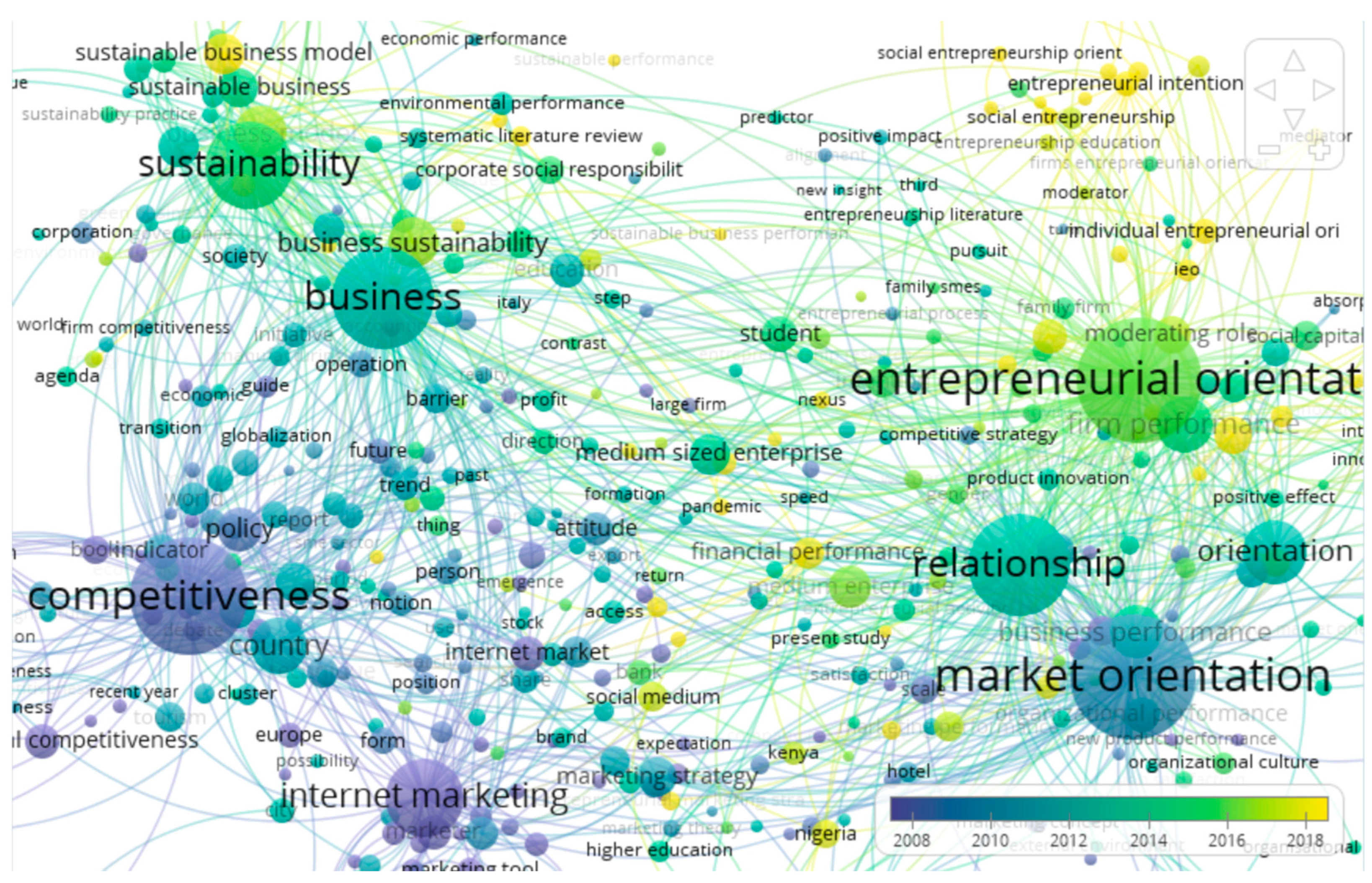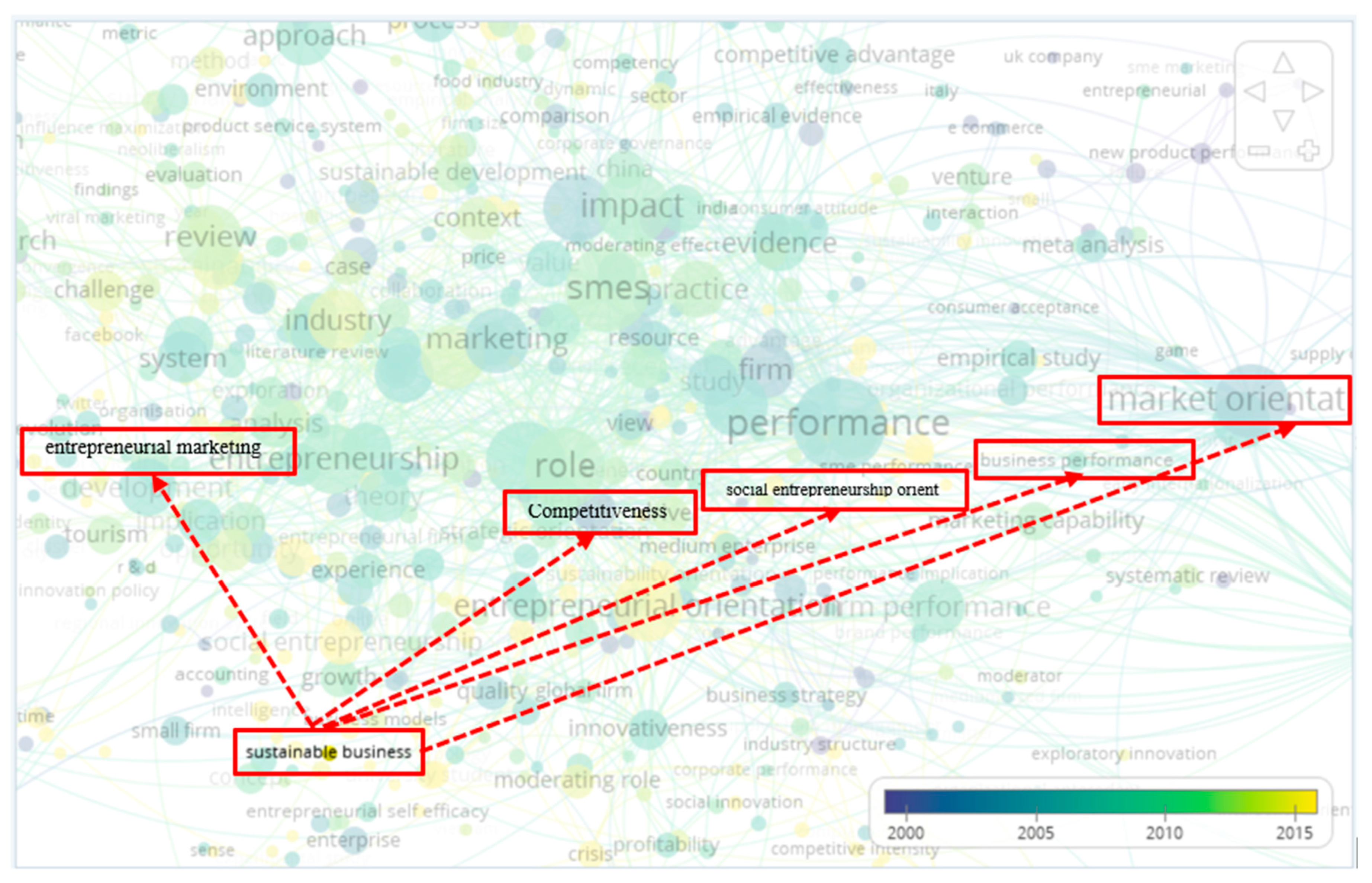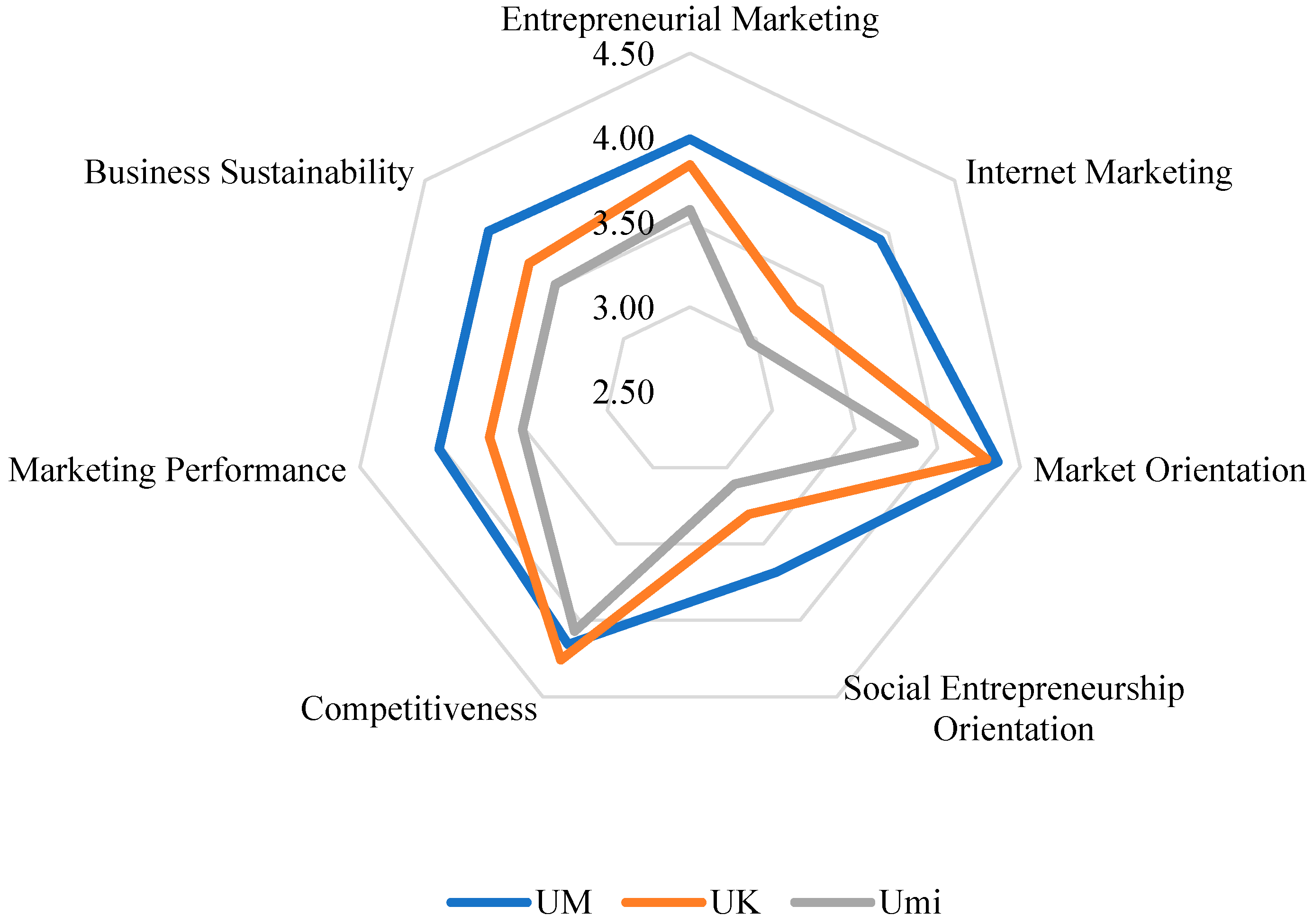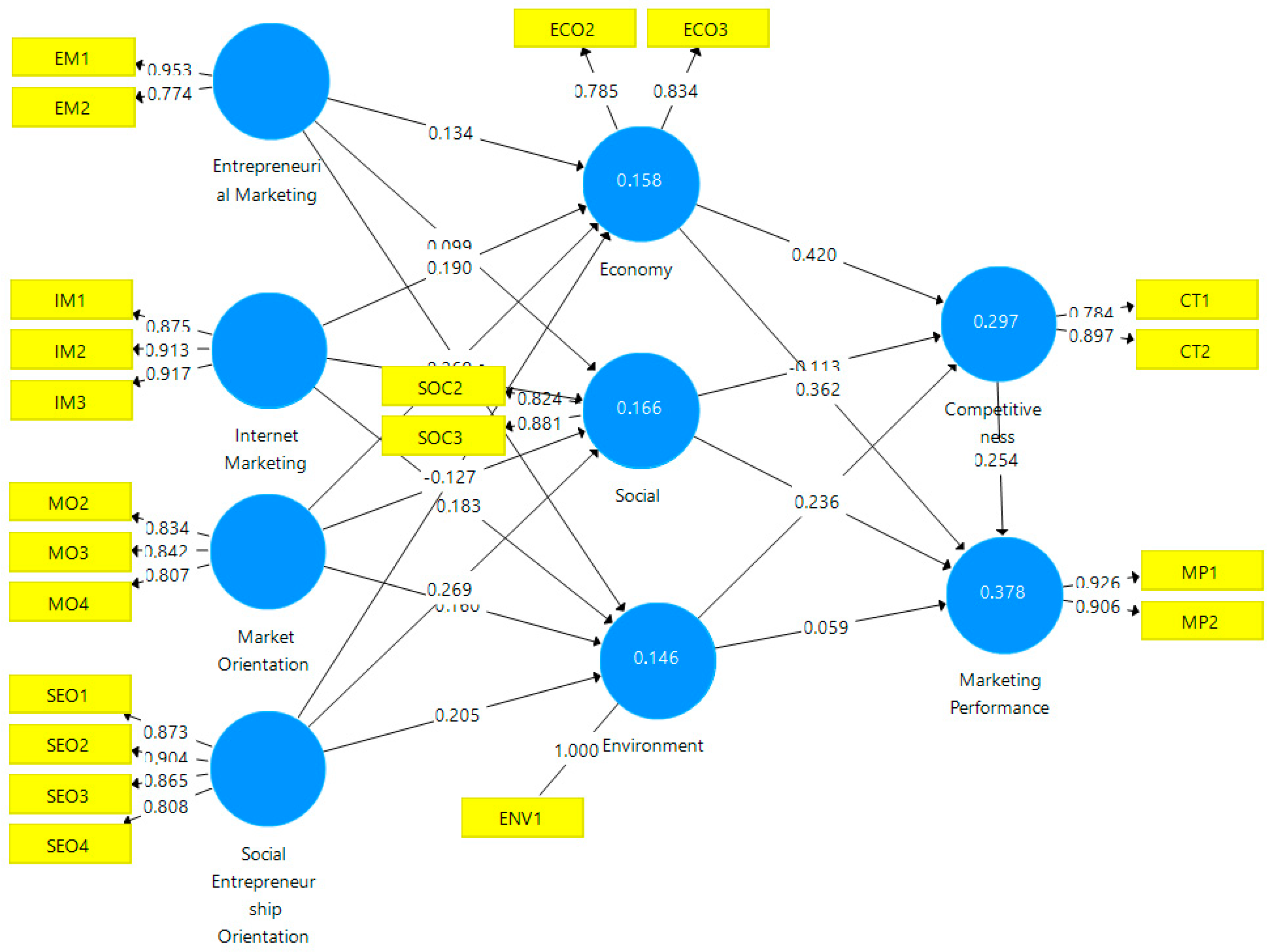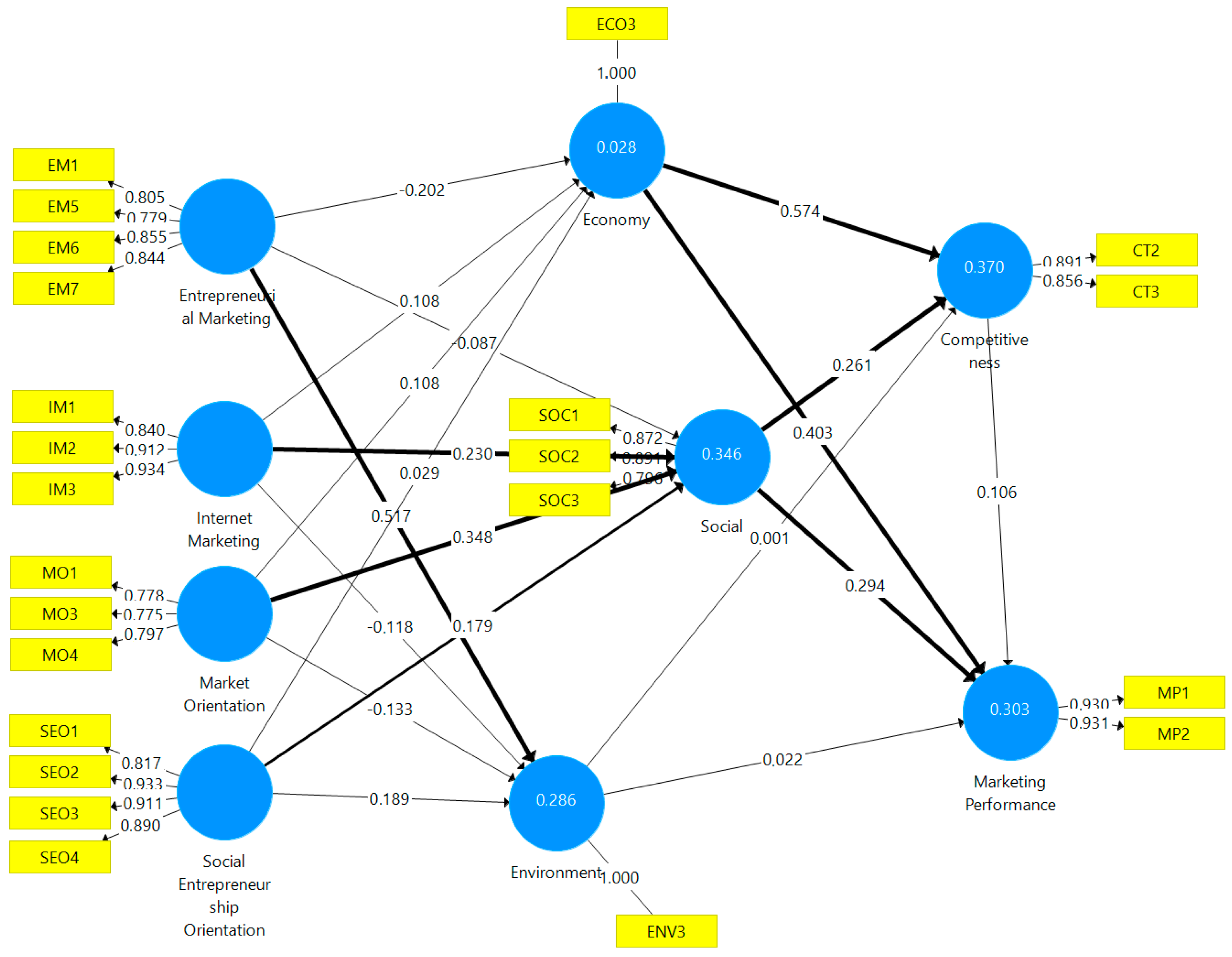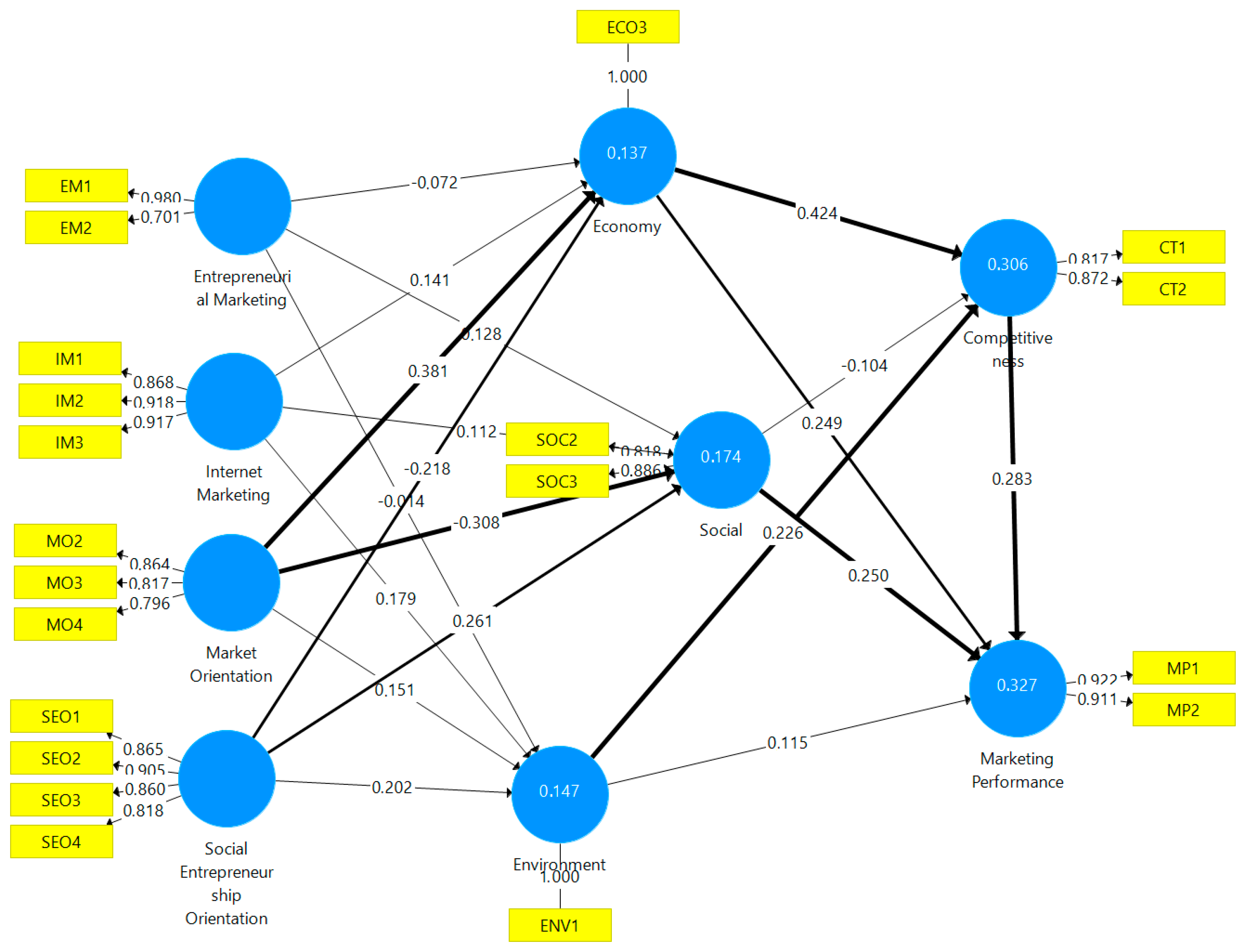In this study, SEM-PLS analysis was used to show how the influence of marketing entrepreneurship, Internet marketing, market orientation, and social entrepreneurship orientation on business sustainability and its impact on the competitiveness and marketing performance of MSMEs; this was achieved by using SmartPLS 3 software with a two-stage embedded approach method, evaluating the model on two levels (the dimension and variable levels).
4.4.1. Evaluation of Measurement Model (Outer Model) Dimension Level
Indicator reliability (outer loading ≥ 0.700): If the initial model does not meet the requirements, the removal of indicators (dropping) is carried out one by one on the outer loading value. After dropping the indicator, the research model is calculated again to obtain a research model after dropping the indicator. Twelve indicators in micro-enterprises were dropped in the measurement results because they did not meet the requirements, (namely, an outer loading value of less than 0.700): PRO3, INV4, RSK2, OFC3, OFC4, INT1, INT2, RSR1a, RSR1b, PRC1, QLT1, and PFT1. Then, in small and medium enterprises (SMEs), several indicators did not meet the criteria, namely, PRO1a, PRO1b, INV3, INV4, RSK1, RSK2, OFC3, OFC4, INT1, INT4a, INT4b, RSR1a, RSR1b, RSR3b, RSR4, SCL3, PRC1, QLT1, QLT4, and PFT1.
Internal consistency reliability (CA, CR ≥ 0.600): Furthermore, a construct reliability assessment was carried out by looking at the Cronbach’s alpha (CA) and composite reliability (CR) values, shown in
Table 5 and
Table 6. It can be seen that there are still three dimensions, namely economy, environment, and risk-taking, which have a CA value below 0.600 (unreliable) in micro-businesses. Therefore, the dropping of indicators that have low factor values in each dimension was carried out. Indicators removed from the model in micro-businesses were OFC1 (opportunity focus) and RSK3 (risk-taking). After removing the indicators from the model, the model was recalculated to produce a new CA value that met the requirements.
Furthermore, in small and medium enterprises, all dimensions used in the measurement were found to be reliable, as illustrated in
Table 6.
Convergent validity (AVE ≥ 0.500): The next step was to assess validity through the AVE (average variance extracted). The AVE of every construct must be above 0.500. If the AVE is less than 0.500, it is considered inadequate, because more variance is due to error variance than indicator variance [
72]. The results of the AVE output are shown in
Table 7.
Based on
Table 7, the overall dimensional AVE can be accepted as having good convergent validity because the AVE in each dimension is above 0.500 in both micro-small and medium enterprises. This means that the variance that can be captured by the construct is greater than the variance generated by measurement error, so the model is said to be good.
Discriminant Validity (HTMT ≤ 0.900). Finally, discriminant validity is tested by looking at the HTMT value. This value is now more highly recommended to be reported because it has a higher level of sensitivity than the Fornell–Larcker criterion and cross-loadings. The HTMT values between the dimensions of technology orientation–digital leadership capability; social risk-taking–social innovativeness; socialness–social innovativeness; and social risk-taking–social proactiveness in micro-businesses did not qualify, with consecutive values of 0.917; 0.967; 0.946; and 0.914. Thus, the removal of indicators in each dimension is related to the average value of the highest indicators’ correlations between dimensions. The indicators removed from the model were TCO1, SIV2, SIV3, SRT1, and SPA1. In small and medium enterprises, the HTMT values between the dimensions of sales growth–customer growth and technology orientation–resource leveraging did not meet the requirements, with consecutive values of 0.952; and 0.939. Thus, the indicators in the dimensions of sales growth (SLS1) and resource leveraging (RSR2) were removed. After the deletion, the model was rerun, and the new HTMT value was below 0.900 for all dimensions in the study.
4.4.2. Evaluation of Measurement Model (Outer Model) Variable Level
After evaluating the measurement model at the dimension level to a good level of validity and reliability, the next step was to evaluate the measurement model at the variable level.
Indicator reliability (outer loading ≥ 0.700): If the initial model does not meet the requirements, the removal of indicators (dropping) is carried out one by one on the outer loading value. After dropping the indicator, the research model is calculated again to obtain a research model after dropping the indicator (
Figure 5 and
Figure 6). Nine indicators were dropped in the measurement results in micro-businesses because they did not meet the requirements (namely, an outer loading value of less than 0.700). These indicators are CT1, ECO2, EM3, ENV1, MO2, MP3; EM4, ENV2; EM2. In small and medium enterprises, the indicators that had to be removed from the model are CT3, ECO1, EM3, ENV3, MO1, MP3, SOC1, EM6, ENV2, EM5, EM4, and EM7.
Internal consistency reliability (CA, CR ≥ 0.600): Furthermore, the assessment of construct reliability was carried out by looking at the Cronbach’s alpha (CA) and composite reliability (CR) values, shown in
Table 8 and
Table 9. In micro-businesses, it can be seen that there are still variables that have a CA value below 0.600, namely the economic variable, which is not reliable. Therefore, the indicator with a low value of the loading factor on the variable was dropped. The indicator removed from the model was ECO1. In small and medium enterprises, there was also an unreliable economy variable, so the ECO2 indicator was removed. After removing the indicator from the model, the model was recalculated to produce a new CA value that met the requirements.
Convergent validity (AVE ≥ 0.500): The next step was to assess validity through the AVE. Overall, the AVE of the constructs in both micro-small and medium enterprises can be accepted as having good convergent validity because the AVE of each construct was above 0.500 (
Table 10). This means that the variance that can be captured by the construct was greater than the variance generated by measurement error, so the model can be said to be good.
Discriminant Validity (HTMT ≤ 0.900): All constructs had HTMT values below 0.900, which indicates that discriminant validity was met (
Table 11 and
Table 12).
4.4.3. Structural Model Evaluation (Inner Model)
After ensuring that all constructs were reliable and valid, the next step was to discuss the assessment of the results of the structural model. The first step was to ensure that there were no significant collinearity problems in the structural model by examining the VIF (variance inflation factor) value (
Table 13). A VIF value exceeding 5 indicates potential collinearity problems among the predictor constructs. If the VIF value is between 3 and 5, collinearity is considered uncritical, and if the VIF is less than 3, collinearity is not a problem.
Table 13 shows that there were no constructs with a VIF value of more than 5, so it can be concluded that the structural model does not have significant collinearity problems.
The next step was to assess the significance and relevance of the relationship in the structural model based on the
p-value, using the results shown in
Table 14. If the
p-value <0.100 (sign 10%), then the research hypothesis is supported.
The effect of entrepreneurial marketing on the environmental aspect: There is a significant and positive relationship between entrepreneurial marketing variables relating to the environment in micro-businesses, amounting to 0.517, while in small and medium enterprises, it is not significant. This shows that the better the entrepreneurial marketing, the more it increases the environmental aspect of micro-businesses in Jabodetabek and Sukabumi (by 51.7%). This supports the results of research conducted by [
27], that entrepreneurial orientation has a significant influence on supporting sustainability. Entrepreneurial marketing not only advances business performance but also catalyzes the implementation of sustainable practices that support environmental sustainability [
7,
105]. Entrepreneurial marketing plays a role in the environmental aspect of sustainability by promoting green innovation, resource efficiency, and market education on eco-friendly products, thereby creating a competitive advantage for businesses [
123]. However, entrepreneurial marketing also has potential negative impacts, such as greenwashing, excessive resource exploitation, and increased carbon footprint due to aggressive market expansion [
124]. Therefore, the implementation of sustainable entrepreneurial marketing must balance business growth strategies with environmental responsibility to truly contribute to sustainable development.
The influence of market orientation on the economic aspect: There is a positive and significant relationship between market orientation variables relating to the economy in small and medium enterprises, with a value of 0.381, while in micro-enterprises, there is no significant influence. This means when the market orientation of small and medium enterprises is great, it will increase the economy by 38.1%. This follows the results of several previous studies, which found that market orientation has a positive influence on business performance in the form of increased sales and profits [
38,
44]. Market orientation focuses on understanding consumer needs and providing more value to consumers to build strong relationships. This can have an impact on the profitability and economic sustainability of the company [
125]. Good market orientation allows MSMEs to effectively collect market information, analyze emerging trends, and identify opportunities and threats in the market, which in turn improves sales performance [
126]. Thus, the implementation of effective market orientation can increase profitability and ensure the long-term economic sustainability of the company.
The effect of market orientation on the social aspect: In both micro-small and medium enterprises, there is a significant relationship between market orientation variables and the social aspect. However, the direction of the relationship between micro-enterprises and small and medium enterprises is different. In micro-businesses, the market orientation variable positively affects the social variable by 0.348. This means that the higher the market orientation in micro-businesses, the higher the social aspect will be (by 34.8%). Meanwhile, in small and medium enterprises, market orientation has a negative effect (of −0.308) on the social aspect. This means that the higher the market orientation in small and medium enterprises, the lower the social aspect (by 30.8%). Conversely, the lower the market orientation, the higher the social aspect (by 30.8%) in small and medium enterprises in Jabodetabek and Sukabumi. Effective market orientation can strengthen the company’s CSR activities, which not only focus on financial profit but also social welfare. This shows that good CSR can improve the company’s image and strengthen relationships with stakeholders, thus increasing business sustainability. In addition, effective market orientation also allows SMEs to improve their performance, which in turn can strengthen their contribution to the surrounding community and improve the quality of life of the surrounding community [
126]. Therefore, the implementation of proper market orientation can increase profitability and ensure the company’s social sustainability in the long term.
The effect of Internet marketing on the social aspect: In micro-businesses, the Internet marketing variable has an effect of 0.230 on the social aspect, while in small and medium enterprises, there is no significant influence. This shows that with greater intensity of Internet marketing utilization in micro-businesses, the social aspect will increase by 23%. This aligns with the results of research conducted by [
61], showing that Internet marketing plays an important role in marketing products that are not only of economic value but are also of environmental and social value, which supports business sustainability. Product and service innovation driven by Internet marketing helps to meet consumer needs and contributes to social welfare [
127]. Through Internet marketing, companies can more easily interact with customers, raise awareness about social issues, and encourage consumers to adopt more socially responsible behaviors. Digital marketing not only boosts sales but also empowers communities, enhances community engagement, and improves social well-being [
128].
The effect of social entrepreneurship orientation (SEO) on the economic aspect: Social entrepreneurship orientation in small and medium enterprises has a significant negative influence (of −0.218) on the economic aspect. This means that when social entrepreneurship orientation is increased, it can reduce the economy by 21.8%. Conversely, when social entrepreneurship orientation is lowered, it can increase the economy by 21.8%. This aligns with research conducted by [
66] that social entrepreneurship involves risk and innovation in the process of taking profits, and when focusing on social goals, entrepreneurs need to understand that the possible benefits received are not direct profits.
The influence of social entrepreneurship orientation (SEO) on the social aspect: In micro-businesses and small and medium enterprises, there is a significant positive relationship between the social entrepreneurship orientation variable and the social aspect (of 0.179 and 0.261, respectively). This means that if there is greater social entrepreneurship orientation, it will be able to increase the social aspect by 17.9% in micro-businesses and by 26.1% in small and medium enterprises. This follows the results of several previous studies which found that SEO has a significant positive influence on social performance [
70,
71,
72,
75]. Social entrepreneurship orientation, especially through hybrid business models and collaborative social innovation approaches, has a positive impact on the sustainability of social entrepreneurship. By combining innovative and collaborative business solutions, social entrepreneurship can create broad social impacts, such as community empowerment and reduced social inequality [
129]. In addition, entrepreneurial orientation has a positive influence on sustainable business performance, which in turn can increase the company’s social contribution to society [
130].
The effect of the economic aspect on competitiveness: Both in micro-enterprises and small and medium enterprises, there is a positive and significant relationship between these variables. The magnitude of the influence on micro-enterprises and small and medium enterprises is 0.574 and 0.424, respectively. This means that when the economy increases, it will be able to increase competitiveness by 57.4% in micro-businesses and will increase competitiveness by 42.4% in small and medium enterprises. This is in alignment with the results of previous studies, which found that the economic aspects of business sustainability encompassed by the fairtrade practice variables have a significant positive effect on business competitiveness in SMEs [
100,
104]. Presenting transparent sustainability reports covering economic, environmental, and social aspects has been shown to have a positive impact on a company’s market performance [
131]. While this is more common in large companies, the same practice can be applied to SMEs. Focusing on economic aspects in sustainability reports, such as cost efficiency and resource management, can improve the competitiveness of SMEs. By reporting sustainability practices clearly, SMEs can build a positive image, attract consumers who care about sustainability, and strengthen their position in a competitive market.
The effect of the economic aspect on marketing performance. There is a positive and significant relationship between economy and marketing performance variables in micro-enterprises and small and medium enterprises with effect sizes of 0.403 and 0.249, respectively. This means that when the economy increases, it can increase marketing performance in micro-businesses by 40.3% and in small and medium enterprises by 24.9%. This is in accordance with the results of several previous studies, which found that sustainability practices together with social, environmental, and economic requirements from stakeholders can positively influence market performance [
33,
105,
106]. Implementing effective marketing strategies by considering economic factors as part of business sustainability, such as production costs, prices, and distribution, can improve the marketing performance of MSMEs, which in turn also strengthens their competitiveness in the market.
Social aspects influence competitiveness: Social variables positively and significantly impact competitiveness in micro-businesses, with a value of 0.261. This means that when social variables are increased, competitiveness can increase by 26.1%. These results are in alignment with the results of previous studies, which found that the social aspects of business sustainability described in the human-centricity variable have a significant positive effect on business competitiveness in SMEs [
100,
104]. By implementing effective corporate social responsibility (CSR) practices, MSMEs can build a positive reputation, increase customer loyalty, and attract investors who care about social issues. The company’s active support of social activities has a positive influence on the surrounding community, which in turn improves the company’s image [
132]. In addition, the implementation of social aspects can also improve the company’s financial performance, which contributes to better competitiveness [
133]. Thus, MSMEs that focus on the social aspects of sustainability not only contribute to the welfare of society but also strengthen their competitive position in the market.
Social aspects influence marketing performance: Social variables have a positive and significant effect on marketing performance in micro-businesses and small and medium enterprises, with effect sizes of 0.294 and 0.250, respectively. This means that when the social aspect increases, it can increase marketing performance in micro-businesses by 29.4% and in small and medium enterprises by 25%. This is following several previous studies that found that sustainability practices together with social, environmental, and economic requirements from stakeholders can positively influence market performance [
33,
105,
106]. Implementing effective marketing strategies that take into account social factors such as customer relationships, corporate social responsibility, and community involvement can improve the competitiveness and marketing performance of MSMEs.
The effect of the environmental aspect on competitiveness: The environmental variable has a positive and significant effect (of 0.226) on the competitiveness of small and medium enterprises. This means that if these small and medium enterprises place strong emphasis on environmental aspects, they can increase their competitiveness by 22.6%. This is in accordance with previous research, which found that the environmental aspects of business sustainability described in the sustainability practice variables have a significant positive influence on business competitiveness in SMEs [
100,
104].
The effect of competitiveness on marketing performance: There is a positive and significant effect (of 0.283) of the competitiveness variable on the marketing performance of small and medium enterprises. This means that the higher the competitiveness, the more the marketing performance of small and medium enterprises will increase (by 28.3%). This is in alignment with previous studies, which found that competitiveness has a positive and significant relationship with performance [
7,
112,
118].
The third step is to test the coefficient of determination (R
2) of the endogenous construct. The R
2 values range from 0 to 1, with higher values indicating stronger explanatory power. As a general rule of thumb across social science disciplines, an R
2 value of 0.75 is considered substantial. A value of 0.50 is considered moderate, and one of 0.25 is considered weak [
134].
The results in
Table 15 show R
2 values of 0.370, 0.028, 0.286, 0.303, and 0.346 for the endogenous constructs of competitiveness, economy, environment, marketing performance, and socialness, respectively, in micro-enterprises; this confirms moderate predictive accuracy, except for the endogenous variable of economy, which has weak predictive accuracy. Competitiveness is increased by 37%, economy by 2.8%, environment by 28.6%, marketing performance by 30.3%, and socialness by 34.6% when entrepreneurial marketing, Internet marketing, market orientation, and social entrepreneurship orientation are integrated. In SMEs, R
2 values of 0.137, 0.147, and 0.174 for the endogenous constructs of economy, environment, and socialness, respectively, confirm weak predictive accuracy, while the endogenous constructs of competitiveness and marketing performance have moderate predictive accuracy, with values of 0.306 and 0.327. Economy is improved by 13.7%, environment by 14.7%, socialness by 17.4%, competitiveness by 30.6%, and marketing performance by 32.7% when entrepreneurial marketing, Internet marketing, market orientation, and social entrepreneurship orientation are integrated.

